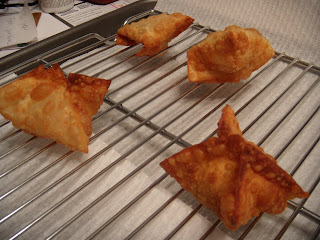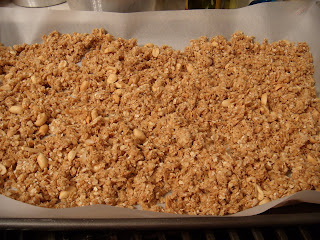This was such a fun recipe and another great option for party appetizers or a way to experiment with these different fillings and tastes. I knew this recipe was something I wanted to make, but I also thought plain cream cheese was a bit ho-hum. But by digging through the fridge and pushing the limits a bit, I was able to create some pretty awesome taste combinations.
Cream Cheese Dumplings
Heat olive oil (about 2 inches) in a large, deep skillet
Take two blocks of cream cheese and mix them with any of the following:
Feta cheese
Goat
cheese
Garlic
Basil
Oregano
Sun dried tomatoes (in oil, drained and minced)
Salt
Pepper
Take wonton wrappers and lay them on a flat surface. Place a small spoonful of mixture in the center of the wrapper and lightly wet seams all the way around with water.
Pinch corner to corner to seal (will make an X pattern when looking straight down at it). Place wontons in oil and fry on each side until brown. Drain on paper towels
The only thing about this recipe that I didn't care for was the fact that my house smelled like the back of a greasy diner for a day or two after making the dumplings. I even had the vent on when the frying was taking place and it didn't trap all of the smell. But they were absolutely worth it.
The recipe says to use olive oil for frying, but I used canola oil. I also used low-fat Philly Cream Cheese and it turned out completely fine. I normally wouldn't advocate using fat-free in something like this, just because you never know about the consistency, but the low-fat was great. For the fillings, I followed a few of the choices from the actual recipe but I also threw in a few of my own:
Cream Cheese, Sun Dried Tomatoes and Basil
This kind of tasted like a pizza, only better. The sun dried tomatoes (packed in oil) had a nice warmth and the basil (fresh from my little potted plants outside) gave it that bite.
Mozzarella, Turkey Pepperoni and Basil
Here I used a mozzarella string cheese stick that I cut into chunks, and I cut the turkey pepperoni slices into quarters, and slivered the basil. It worked really well, except that the cheese didn't hold up as well as I had hoped. It melted and expanded in the hot oil, of course, but then it cooled down significantly and kind of turned into a blob. It tasted good, though.
Cream Cheese, Feta Cheese and Diced Garlic
Another delicious one! The feta really broke through and overpowered the cream cheese, which is exactly what I was hoping would happen. The garlic was great, too, after being super heated with the hot oil.
Diced Shrimp and Hoisin Sauce
Ooh, you weren't expecting this one, were you? Hoisin sauce is a Chinese dipping sauce, like soy sauce or plum sauce. I had this sauce on hand for a recipe I found in Cooking Light, Hoisin Glazed Beef Kebabs. I used frozen cooked shrimp that I thawed and diced into small pieces and mixed them with a teaspoon or so of the hoisin. Pretty good, but I think it was a solid third place as compared to some of the other mixtures I tried.

When the dumpling is folded, you see the "X"

Cooling on the wire rack after coming out of the oil
Now I can't imagine these are all that good for you, but they're certainly fun to make and they definitely taste good. I used a large pot to fry in, but a deep fryer would also be the best choice. The wonton wrappers I used are Nasoya Wonton Wraps and I was able to find them at a few stores in town. They're refrigerated and usually found in the produce section, at least in my area. They're about 2"-3" square and come in a pack of 60 or so. When they go into the oil, they literally take no more than three or four minutes until they are crisp and brown and ready to come out. Please resist the urge to eat one immediately and do give them time to cool off.
I will definitely make these again and I'll do a few more combinations. I'd love to do one with chocolate, but I don't how well it would respond to the high temperatures since chocolate can burn easily. I think fruit might be good, too. Or, you can cut the wrappers into strips and fry them. From there, they can be used to top soup or just put out in a bowl for people to snack on. Pretty versatile!
















